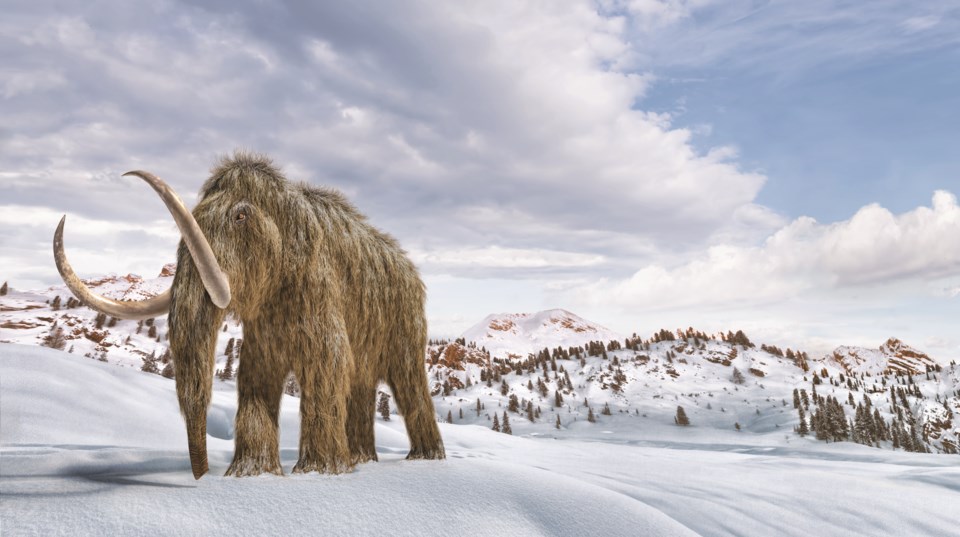Last summer, a placer miner in the Yukon found a frozen, fully preserved baby mammoth in 40,000-year-old sediment he was chopping through. Last week it was a retired teacher who found the shoulder blade of a mammoth while out walking her dogs in Alberta. I’m paying attention to “mammoth” news because I’ve been working on a feature about them for a national magazine. And after a few hours in a howling storm up on the mountain today, it felt enough like the Ice Age winter we deserve that I thought, hey—why not write a little ditty about mammoths?
The extinct genus Mammuthus belongs to the family that contains modern elephants (Mastodons—often confused with mammoths—are but a distant and archaic cousin to this lineage). Starting 5 million years ago, various mammoth species existed in Africa, Europe, Asia, and North America. Last to emerge, 400,000 years ago in East Asia, was the woolly mammoth (M. primigenius), which dominated northern landscapes in Siberia and North America during the Pleistocene, with one population surviving on Siberia’s Wrangel Island until ~3,700 years ago—meaning these creatures still walked the Earth during construction of Stonehenge and the pyramids.
Standing three-metres at the shoulder and weighing six tonnes, wooly mammoths had long, curved tusks and a dense undercoat beneath long guard hairs in colours ranging from blond to dark brown. Both the tail and ears were small to avoid the obvious risk of frostbite—in contrast to today’s pachyderms, whose oversized ears help shed heat.
Having lived with them may account for our genuine affection for mammoths. The much-loved sculptures of a mammoth family at the Canadian Museum of Nature in Ottawa have been its greatest public touchpoints since being installed in 1987. In HBO’s fictional Game of Thrones, mammoths are ridden into battle as modern elephants once were. But these are hardly the first pop-cultural mammoth tropes. Though that likely began with the character “Mr. Snuffleupagus” on Sesame Street—a shy, gentle mammothy thing with large eyelashes and no tusks (i.e., cuddly)—it reached its zenith more recently. “Of all the Ice Age megafauna, two get the most attention. Mammoths and sabre-toothed tigers. They are the superstars—the most popular museum exhibits, the ones that have become metaphor (it was [Thomas] Jefferson himself who popularized the term ‘mammoth’ as a synonym for big), and the literal Hollywood stars. No surprise, it’s Manny the Mammoth and Diego the Sabre-Toothed Tiger headlining the never-ending Ice Age movie franchise,” wrote Steve Brusatte in The Rise and Reign of the Mammals.
In fact, humans like mammoths so much that they may be the first animal to undergo “de-extinction.” In the book How to Clone a Mammoth, molecular biologist Beth Shapiro considers the technology and potential hurdles. She talks about a now infamous TEDx event at National Geographic headquarters in Washington, D.C., in 2013. Meant to take the de-extinction idea beyond sensationalist headlines by highlighting its realities, it failed to shift public opinion, which remains mixed: supporters argue it’s a moral failing not to bring back a species if it’s possible; those against cite the hard costs, dodgy ethics and potential environmental impacts. Often lost in the discussion is what the goal of de-extinction might be—simply resurrecting life or, more hopefully, restoring lost ecosystems?
Shapiro, who studies the DNA of extinct beasties like sabre-toothed tigers, giant bears and even the enigmatic dodo, was unequivocal in answering the most obvious question. “We will never create an identical clone of a mammoth,” she wrote in a let-down for those who took her title literally. This for want of a living mammoth cell, which, of course, doesn’t exist. She notes, however, that a scientific view of de-extinction doesn’t require actually cloning a mammoth to resurrect its traits and behaviours, which can be accomplished by sequencing various mammoth genes from abundant ancient DNA, recreating those in a lab and inserting them into the DNA of an Asian elephant—mammoths’ closest living relative at 99.9-per-cent genetic similarity (the entire genomes of both species have been mapped). But if this sounds like a mere genomic cut-and-paste, note that these genomes are ~3 billion base-pairs long, so at 99.9-per-cent similarity there’s still more than a million base-pair differences to sift through.
Nevertheless, a company co-founded by Harvard geneticist George Church, is looking to do just that. “We’re de-extincting genes, not species,” Church told National Geographic. “The goal is a cold-resistant elephant that’s fully interbreedable with the endangered Asian elephant.” Genes for blood-oxygen capacity at low temperature, hairiness, fat storage and larger size, for example, could make for a shaggier, more-cold-tolerant elephant—a proxy for the woolly mammoth.
Such an organism might even be “field tested” in an area ready-made for reintroduction. For instance, Russian ecologist Sergey Zimov has a unique idea for how to keep permafrost’s carbon frozen in the ground: convert the now swampy, heat-vulnerable Siberian tundra to the kind of high-productivity grazing ecosystem that existed here during the Ice Age. Since 1996, Zimov and son Nikita have worked on their solution—Pleistocene Park, a 20-square-kilometre parcel of lake-constellated tundra. They’ve already introduced self-sustaining populations of reindeer, Yakutian horses, musk ox, bison, and yaks to test their landscape effects, hoping the combination of grazing, bio-fertilization, and critter-compacting of soil and snow return the area to grassy steppe with a less-volatile permafrost layer. In a recent paper in Nature, they report that it seems to be working.
There may be compelling ecological reasons to de-extinct mammoths, but there would also be less pushback, because they don’t seem threatening in a Jurassic Park kind of way. In fact, if you live in the Yukon, it’s easy to imagine seeing them around. As Shapiro whimsically notes with respect to the ethics of de-extinction, “The Elephant in the Room is a Mammoth.”
Leslie Anthony is a biologist, writer and author of several popular books on environmental science.




